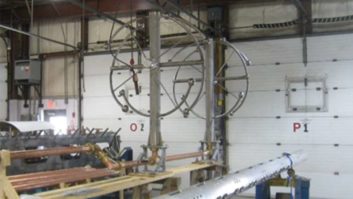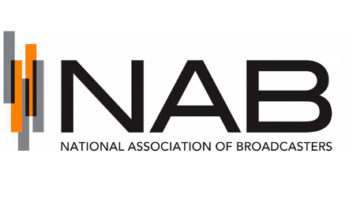The latest in a long and impressive line of broadcast engineering reference books issued by the National Association of Broadcasters is now shipping. I’m referring, of course, to the 11th edition of the NAB Engineering Handbook.

The appearance of each of these volumes is something of a signal occasion; they aren’t exactly published on a regular basis. (The first Engineering Handbook appeared in 1935, and the 10th was released in April 2007, more than a decade ago; that’s just 11 books in 82 years.)
These encyclopedic volumes aren’t produced overnight, either — the “call for authors” for this latest edition went out in mid-2015.
Speaking of authors, the list of contributors to the new handbook reads like a “Who’s Who” in broadcast engineering. More than 125 authors are credited with helping produce the book. (I contributed the “HF Shortwave Radio: Allocation, Design Methods, and Regulation” chapter of the new edition.)
MASSIVE TOME
It seems that each of the handbooks is more ponderous than the last. This new edition weighs close to six pounds and encompasses 99 chapters spread across 1,947 pages, reflecting the tremendous expansion of the broadcasting industry and its allied technologies. By comparison, the first handbook was a scant 100 pages.
Obviously, it’s impossible to provide a complete description of everything covered in this massive tome, given the limited amount of review space available, but I will try to include most of the highlights.
The handbook straddles the radio and television engineering communities, including ground common to both, with detailed information on such fundamentals as the electromagnetic spectrum; signal coverage; frequency coordination; regulatory matters; facility documentation; emergency alerting; management of engineering projects; safety considerations for those working at broadcast facilities; and the design, construction, maintenance and lighting of broadcast towers.
It also covers facility lightning protection; acoustics/noise control techniques applicable to construction of broadcast studios; facility automation; microphones for broadcast applications; state-of-the-art compression technologies; studio-to-transmitter linkage; satellite uplinks and downlinks; fiber optic transmission systems; transmission lines; system measurement techniques; grounding; and electrical power systems, including backup power — just to name a few.
In light of Hurricanes Harvey and Irma, there’s one chapter that should be required reading for everyone whose responsibilities include broadcast transmission facilities. That’s “Broadcast Facility Security, Safety, Disaster Planning, and Recovery.” The words of contributor Joseph Pollet in describing some of his experiences at New Orleans’ WWL in 2005 during devastating Hurricane Katrina are hauntingly prescient, based on what transpired in Texas and Florida 12 years later.
EXPANDED AND UPDATED
The radio-specific content of the handbook has been expanded considerably since the previous edition (21 chapters versus 15, and more than 400 pages, as compared to the 332 in the 10th edition). Topics covered are similar to those in the 2007 edition of the handbook (FM/AM translators and boosters, AM antennas and coupling/phasing technology, AM antenna maintenance, digital radio broadcasting systems in use around the world today, radio data transmission, etc.).
However, this newest edition of the handbook reflects industry technological and business trends and movements. Gone is a section that dealt with AM stereo broadcasting, as well as a chapter on AM/FM field strength measurements (though information about such FM field strength measurements is incorporated into the “FM Antenna Performance Measurements” chapter).
Added are chapters on Internet interfacing and streaming, duplexing/combining at AM transmission facilities, HF shortwave radio, synchronous AM broadcasting technology, and more. There’s even a chapter devoted exclusively to the planning and setting up of radio remote broadcasts. Also, look for a very “beefed-up” chapter (18 pages this time, as compared to the slightly more than four in the 10th edition) on method of moment modeling of AM arrays.
COMPREHENSIVE
Other chapters and sections in the new edition have been expanded or updated to reflect industry and technological changes over the past decade or so.
A good example is the “AM and FM IBOC Systems and Equipment” chapter that appeared in the 10th edition of the Handbook and provided a comprehensive look at what was then a relatively new digital broadcasting modality. The latest edition retains the “deep dive” into IBOC technology, along with background and chronology of developments in getting IBOC HD radio to the marketplace, and adds information about the numerous developments and changes that have occurred since the last Handbook was published, including FM digital power increases, asymmetrical sideband operation and even the 2016 report evaluating the effect/impact of Modulation Dependent Carrier Level (MDCL) on AM IBOC transmissions.
This section runs almost 50 pages and has to be one of the most comprehensive descriptions of IBOC HD technology available in a single publication. The numerous illustrations and charts included make it easy to visualize how the system works and its relationship to existing analog AM and FM carriers. The “pictures” (graphics) included are worth many times those proverbial “thousand words.”
Another technology that has grown by bounds in recent years was not ignored by the book’s editor and authors. This is IP-based transport of signals, and the 11th edition of the Engineering Handbook provides a lot of useful information on audio over IP in the “Audio Contribution and Distribution Methods” chapter. The chapter also drills deeply into just about all other ways to get program audio from one place to another, including “plain old analog,” and the various digital service flavors that have been offered by the telco folks, such as DS1, T1, Switched 56, ISDN and DSL.
With regard to “Ma Bell” connectivity, there’s even a section about “dealing with telco.” It notes that while technology has made audio connectivity for broadcasters cheaper, it has also diminished the status of broadcasters and their special audio needs to that of “ordinary retail customers.”
Such a comprehensive reference work could never have been produced by one individual. Its editor-in-chief, Gary Cavell, and associate editors Tom Osenkowsky, David Layer, Skip Pizzi and Bill Hayes have tapped some of the best and brightest minds in the business to prepare chapters and sections that reflect their particular areas of expertise and experience.
In designing the 11th edition, Cavell and his team wanted to make sure that the book would be a practical engineering reference source, rather than a something resembling a college textbook for an advanced course.
“My goal [was] for us to craft this latest edition not as a heavy scholarly work filled with equations and esoterica that will sit on shelves unopened, but as an approachable, easily understood reference that will be used often,” Cavell said.
Cavell and his group have achieved this goal. I can guarantee that this is one book that won’t just sit on your bookshelf or desk collecting dust; you’ll find yourself referring to it on a regular basis.
My only (admittedly slight) issues are the absence of color illustrations and the small size of some (admittedly a minority) of artwork that is included. Color would definitely have enhanced “readability” of a number of the many, many charts and photos. However, even in the 21st century, color printing is considerably more expensive than black-and-white and would likely have proportionally increased the price tag.
While the size of the overwhelming majority of illustrations is adequate, there are a few cases where a hand magnifier is needed to bring out some of the detail unless you have extraordinary eyes.
GET YOUR OWN COPY
The 11th edition of the NAB Engineering Handbook is available from the NAB’s online store (www.nabstore.com), Amazon, Barnes and Noble and other booksellers. Look for ISBN 978-1-138-93051-3; published by Focal Press.
The list price is $220, but at the time of this review, the NAB store was offering the volume at a special sale price of $187. There are also e-book editions available. Barnes and Noble is offering a Nook Book version for $192.99, and Amazon has priced its Kindle edition at $176.
(Hint: when searching the websites of these two booksellers, type in “National Association of Broadcasters Engineering Handbook” rather than just “NAB Engineering Handbook.” If you search for the latter title you’ll just be directed to the 10th or earlier editions.)
Regardless of which format you prefer, this is a rich source of reference in virtually all areas of broadcast engineering and should be part of the library of anyone who is serious about the engineering side of the profession.
James E. O’Neal is a retired broadcast engineer and the former Technology Editor of TV Technology magazine. He contributes to TV Tech and Radio World on a regular basis.












